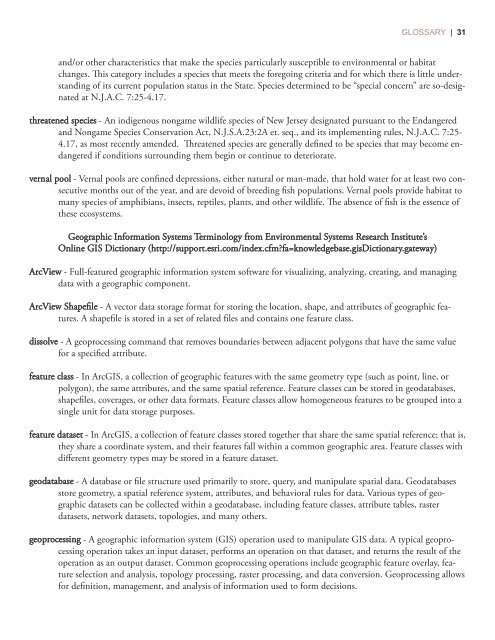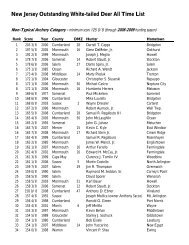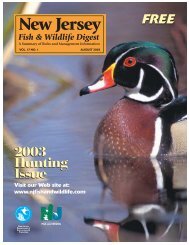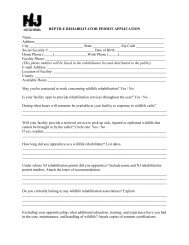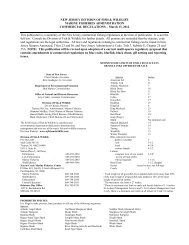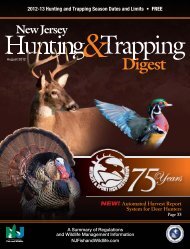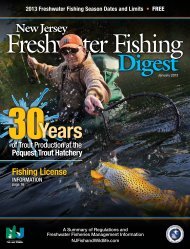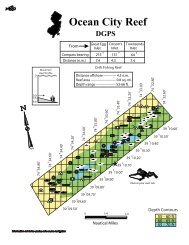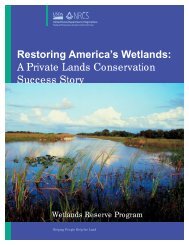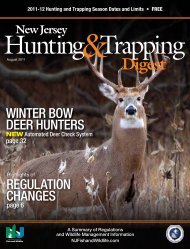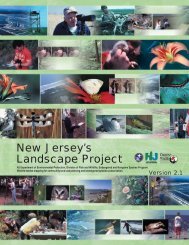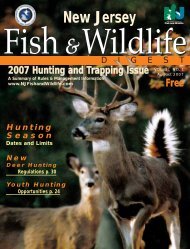Landscape Project Version 3.1 - State of New Jersey
Landscape Project Version 3.1 - State of New Jersey
Landscape Project Version 3.1 - State of New Jersey
Create successful ePaper yourself
Turn your PDF publications into a flip-book with our unique Google optimized e-Paper software.
GLOSSARY | 31and/or other characteristics that make the species particularly susceptible to environmental or habitatchanges. is category includes a species that meets the foregoing criteria and for which there is little understanding<strong>of</strong> its current population status in the <strong>State</strong>. Species determined to be “special concern” are so-designatedat N.J.A.C. 7:25-4.17.threatened species - An indigenous nongame wildlife species <strong>of</strong> <strong>New</strong> <strong>Jersey</strong> designated pursuant to the Endangeredand Nongame Species Conservation Act, N.J.S.A.23:2A et. seq., and its implementing rules, N.J.A.C. 7:25-4.17, as most recently amended. reatened species are generally defined to be species that may become endangeredif conditions surrounding them begin or continue to deteriorate.vernal pool - Vernal pools are confined depressions, either natural or man-made, that hold water for at least two consecutivemonths out <strong>of</strong> the year, and are devoid <strong>of</strong> breeding fish populations. Vernal pools provide habitat tomany species <strong>of</strong> amphibians, insects, reptiles, plants, and other wildlife. e absence <strong>of</strong> fish is the essence <strong>of</strong>these ecosystems.Geographic Information Systems Terminology from Environmental Systems Research Institute’sOnline GIS Dictionary (http://support.esri.com/index.cfm?fa=knowledgebase.gisDictionary.gateway)ArcView - Full-featured geographic information system s<strong>of</strong>tware for visualizing, analyzing, creating, and managingdata with a geographic component.ArcView Shapefile - A vector data storage format for storing the location, shape, and attributes <strong>of</strong> geographic features.A shapefile is stored in a set <strong>of</strong> related files and contains one feature class.dissolve - A geoprocessing command that removes boundaries between adjacent polygons that have the same valuefor a specified attribute.feature class - In ArcGIS, a collection <strong>of</strong> geographic features with the same geometry type (such as point, line, orpolygon), the same attributes, and the same spatial reference. Feature classes can be stored in geodatabases,shapefiles, coverages, or other data formats. Feature classes allow homogeneous features to be grouped into asingle unit for data storage purposes.feature dataset - In ArcGIS, a collection <strong>of</strong> feature classes stored together that share the same spatial reference; that is,they share a coordinate system, and their features fall within a common geographic area. Feature classes withdifferent geometry types may be stored in a feature dataset.geodatabase - A database or file structure used primarily to store, query, and manipulate spatial data. Geodatabasesstore geometry, a spatial reference system, attributes, and behavioral rules for data. Various types <strong>of</strong> geographicdatasets can be collected within a geodatabase, including feature classes, attribute tables, rasterdatasets, network datasets, topologies, and many others.geoprocessing - A geographic information system (GIS) operation used to manipulate GIS data. A typical geoprocessingoperation takes an input dataset, performs an operation on that dataset, and returns the result <strong>of</strong> theoperation as an output dataset. Common geoprocessing operations include geographic feature overlay, featureselection and analysis, topology processing, raster processing, and data conversion. Geoprocessing allowsfor definition, management, and analysis <strong>of</strong> information used to form decisions.


